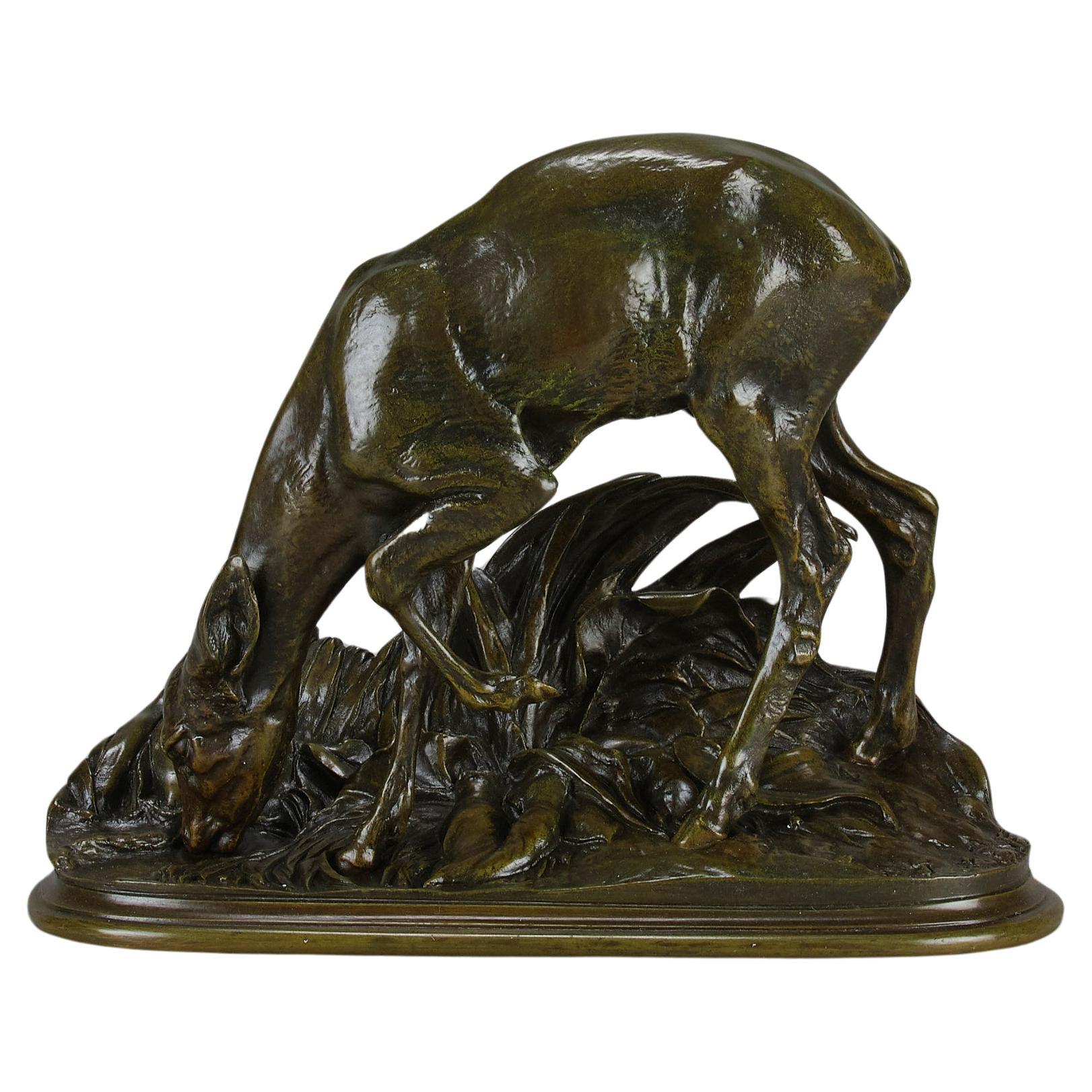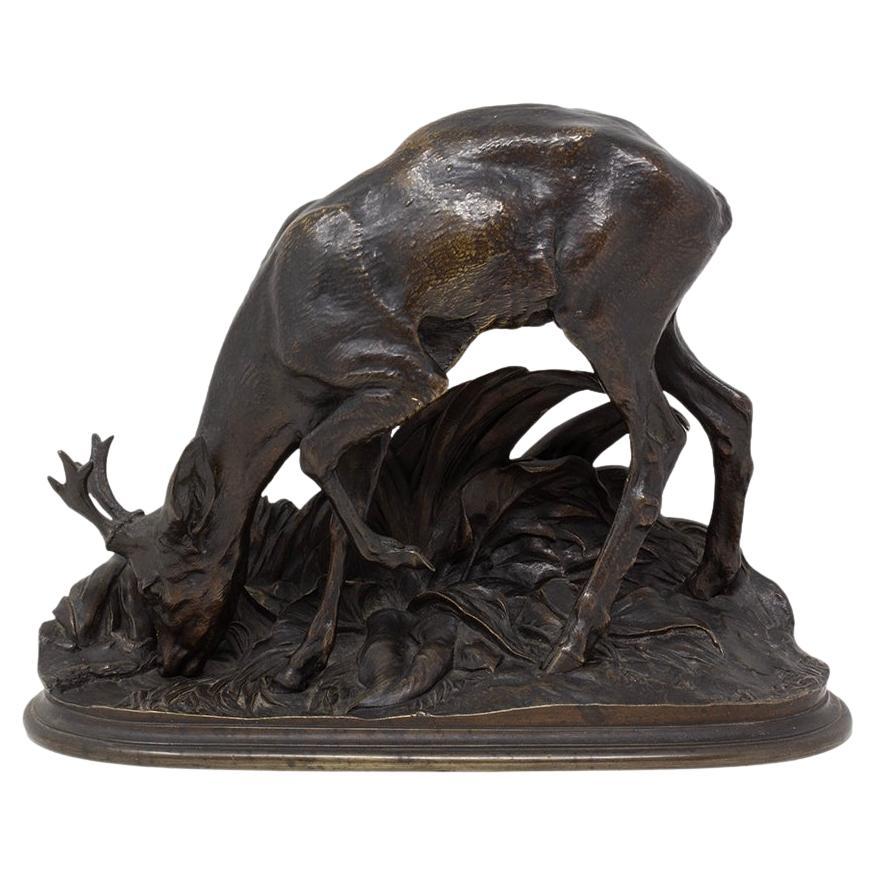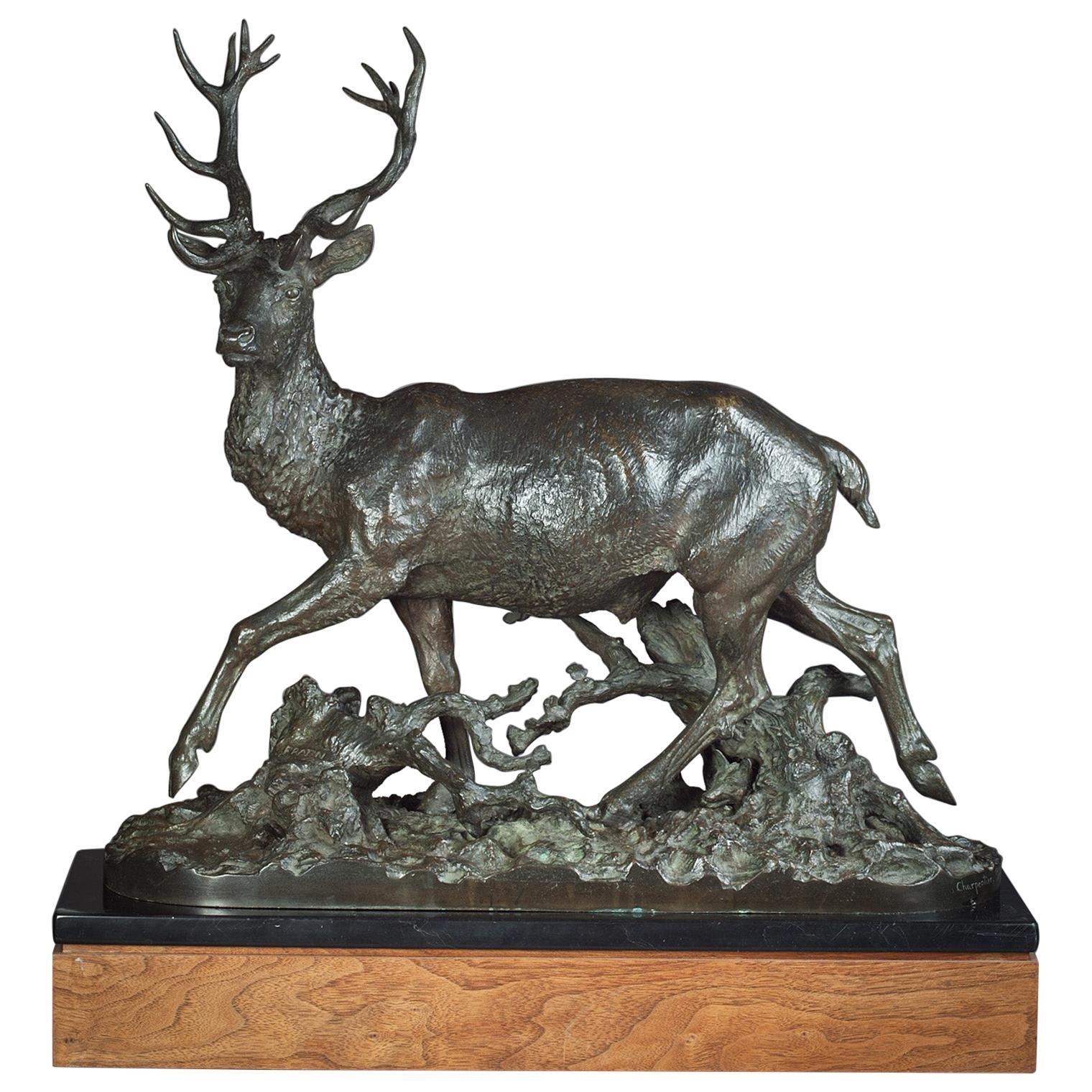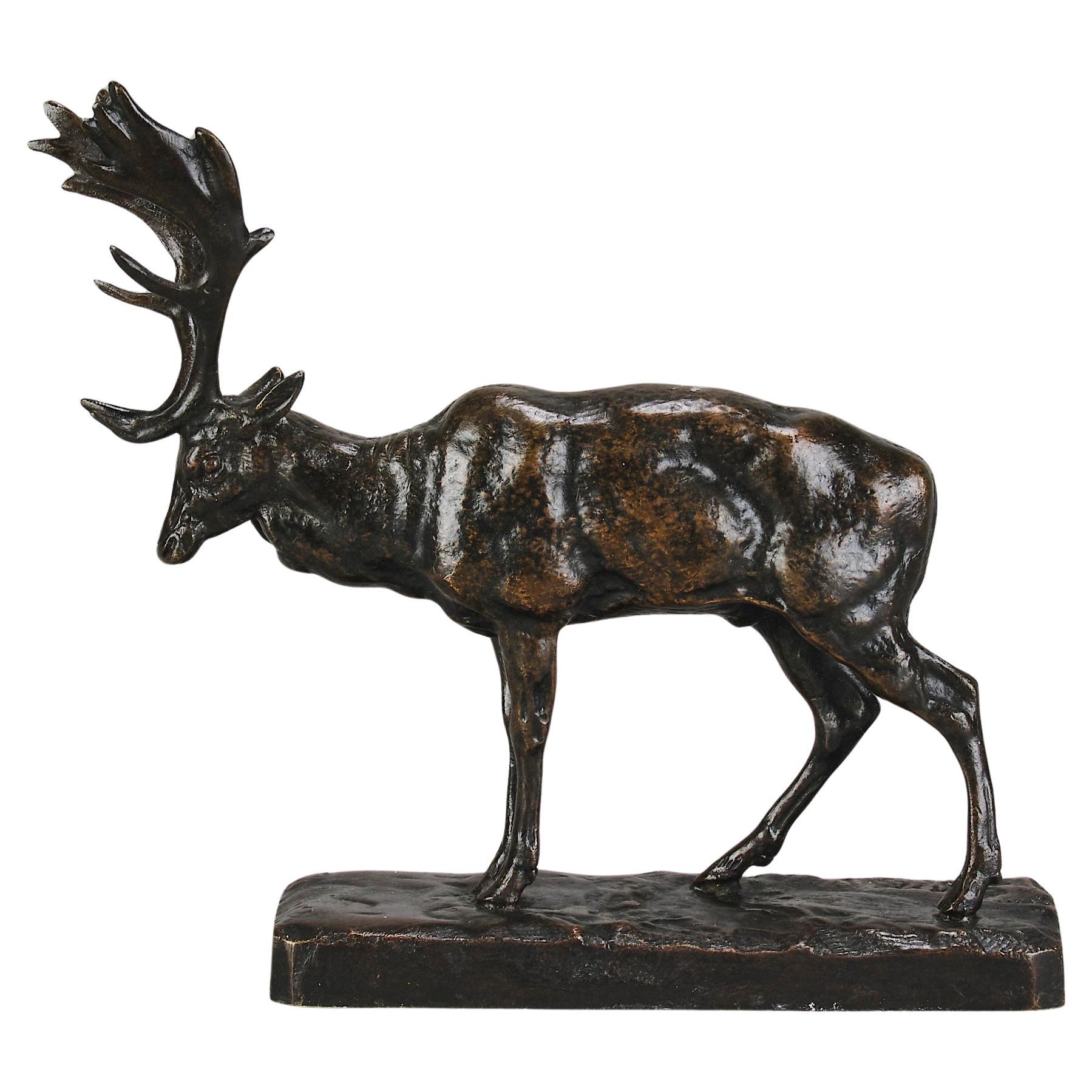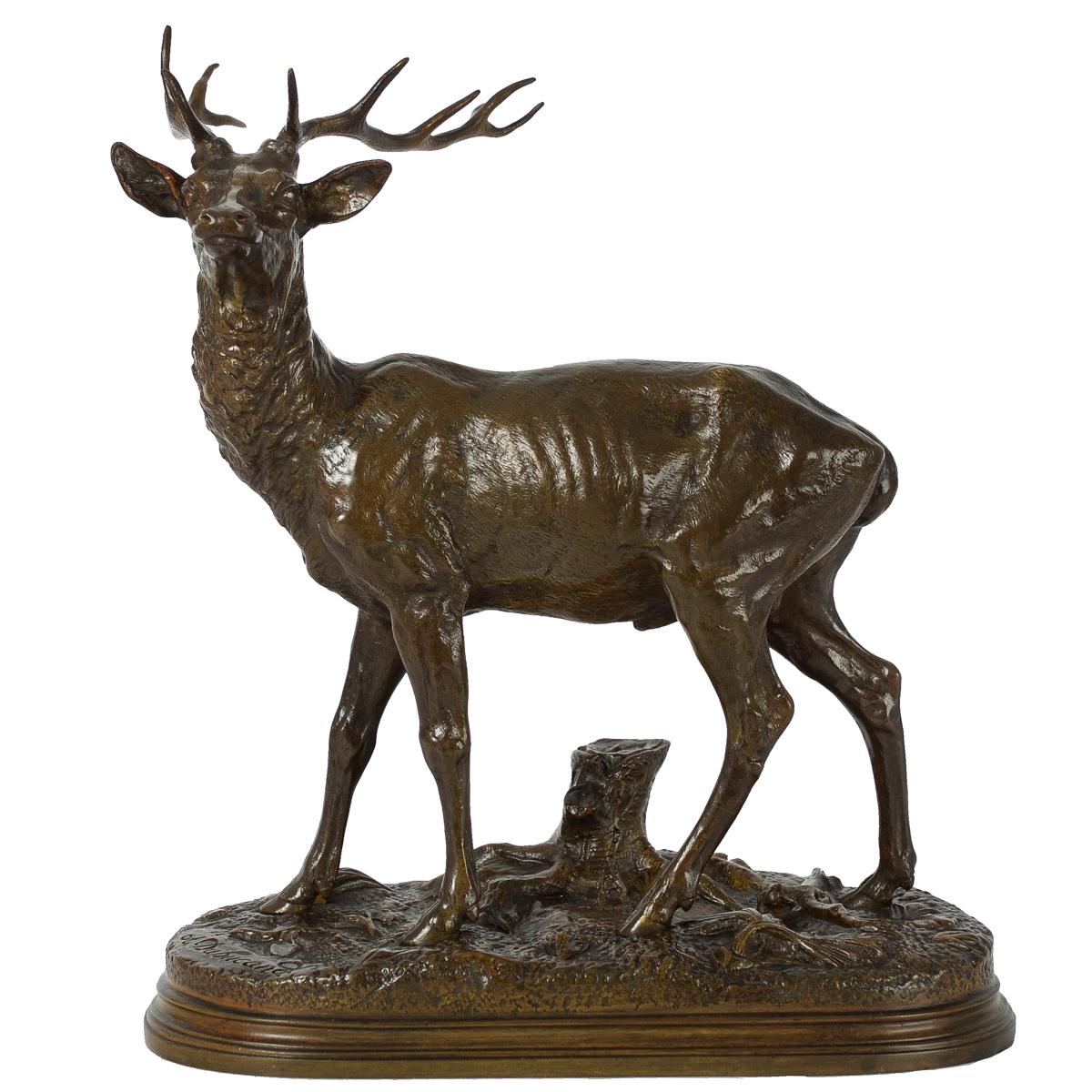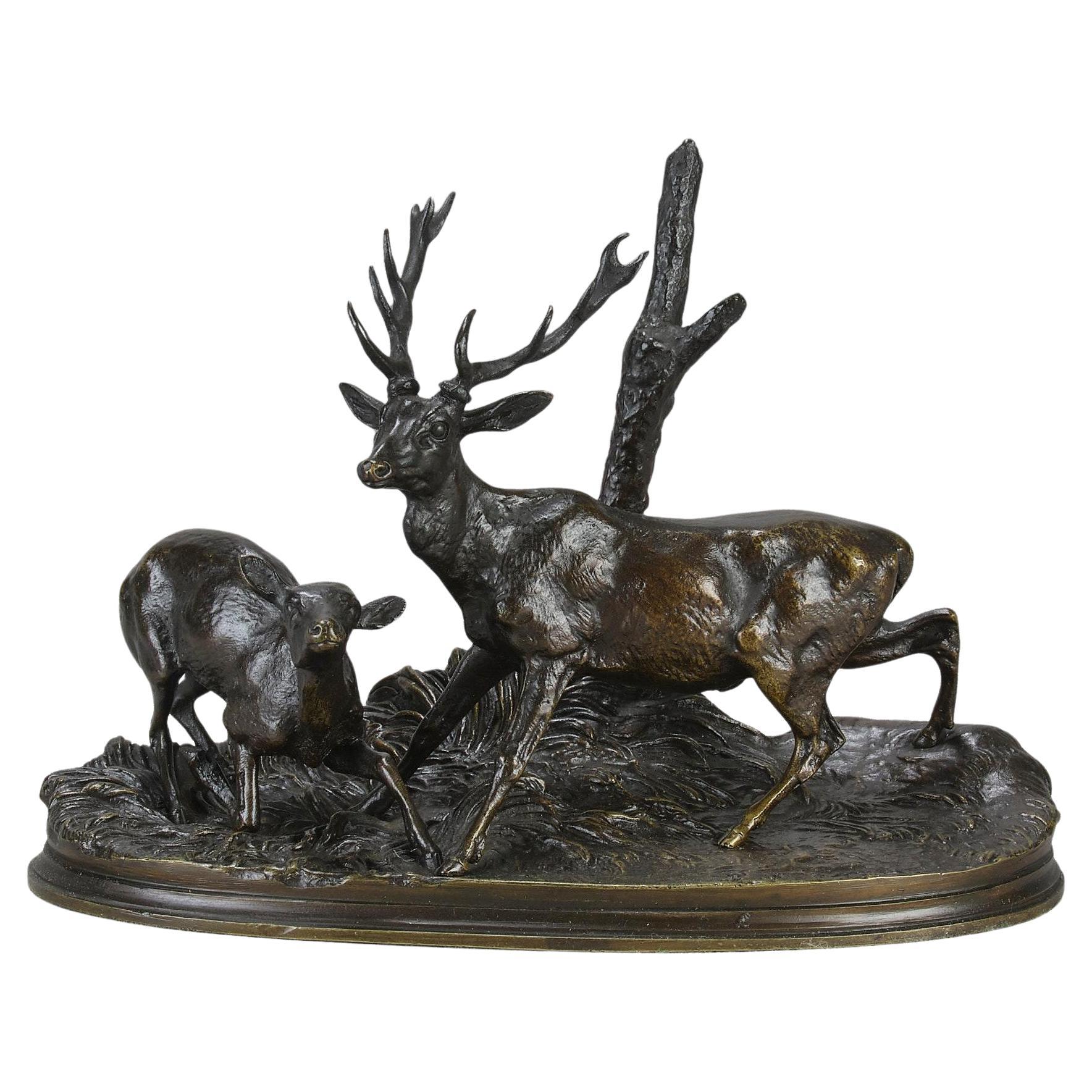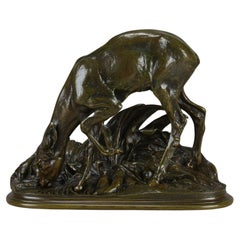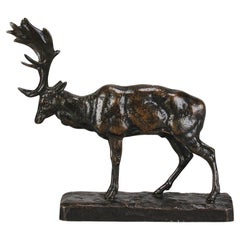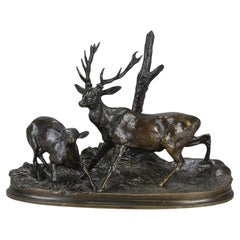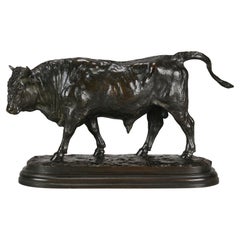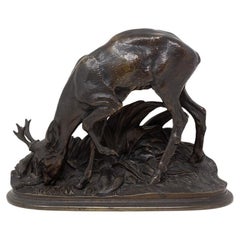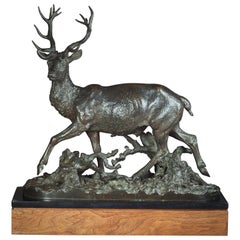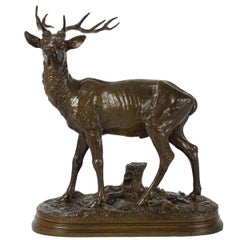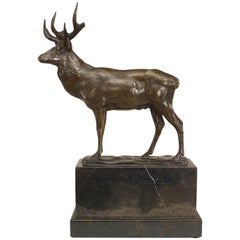Items Similar to 19th Century Animalier Bronze Sculpture Entitled "Reindeer" by Isidore Bonheur
Want more images or videos?
Request additional images or videos from the seller
1 of 13
19th Century Animalier Bronze Sculpture Entitled "Reindeer" by Isidore Bonheur
$5,849.77
£4,250
€4,981.69
CA$7,986.05
A$8,884.15
CHF 4,657.18
MX$108,562.12
NOK 59,303.40
SEK 55,825.95
DKK 37,186.39
Shipping
Retrieving quote...The 1stDibs Promise:
Authenticity Guarantee,
Money-Back Guarantee,
24-Hour Cancellation
About the Item
Excellent late 19th century animalier bronze study of a feeding reindeer with rich brown colour and very fine hand chased and etched surface detail, raised on a stepped naturalistic base, stamped with Peyrol Foundry mark and signed Isidore Bonheur
Additional information
Height: 16 cm
Width: 22 cm
Condition: Excellent Original Condition
Foundry: Peyrol
circa: 1880
Materials: Bronze
SKU: 8211
DESCRIPTION
Isidore Bonheur
Isidore Bonheur, born in Bordeaux May 15 1827. Isidore was the third child of Christine Dorotheé Sophie Marquis (1797–1833), a musician, and Oscar-Raymond Bonheur (1796–1849) (a landscape and portrait painter and an early adherent of Saint-Simonianism, a Christian-socialist sect that promoted the education of women alongside men). Isidore was the brother of Auguste Bonheur and Rosa Bonheur (1822–1899). "It is I who first gave modelling and sculpture lessons to my brother Isidore" (Rosa Bonheur)
In Bordeaux his father had been friends with Francisco Goya who was living there in Exile. In 1828 Bonheur moved to Paris with his mother, brothers and sister, his father having gone ahead of them to establish a residence and income.
He studied painting at first, enrolling in 1849 at the École nationale supérieure des Beaux-Arts, though he made his debut at the Salon (Paris) in 1848 (a Cavalier nègre attaqué par une lionne, plaster, and a drawing of the same subject) and exhibited regularly until 1899. He won medals in 1859, 1865, 1869, took part in the Exposition Universelle (1855), exhibited in London at the Royal Academy of Arts in the 1870s, where he gained great success with equine figures and groups, and won the coveted Médaille d'Or (Gold Medal) with a sculpture entitled Cavalier Louis XV at the Exposition Universelle (1889). He won a silver medal at l'Exposition de Madrid in 1892, a Gold Medal at the Exposition Internationale d'Anvers (1894).
Also in 1894, Bonheur was awarded the status of Knight in the Order of the Immaculate Conception of Vila Viçosa (Cavaleiro da Ordem de Nossa Senhora da Conceição de Vila Viçosa), Portugal. In 1895 he was named Chevalier (Knight) of the Order of Isabella the Catholic, Spain. He was named Chevalier (Knight) of the Legion of Honour on 7 May 1895, decorated 24 May, and breveted 18 September 1895, Paris.
He had given up painting in favor of sculpture early on in his career, though he was noted primarily for his small animalier groups. His studio (atelier) was located at l'Impasse du Moulin Joly, on the corner of rue du Faubourg-du-Temple in Paris.
Isidore Bonheur found a greater market for his work in the mid-nineteenth century in England versus France. In 1870 he gained representation at the Royal Academy and produced a variety of work that catered to English collectors.
Many of his bronzes were edited by the founder Hippolyte Peyrol, his brother in law whom was married to his younger sister Juliette. The Peyrol casts for both Rosa and Isidore Bonheur are exceptionally well executed, which suggests a strong working relationship between the founder and sculptor. There is little doubt that Isidore Bonheur was an acute observer of nature; his animals were not anthropomorphised, but modelled to catch movement or posture characteristic of the particular species. He achieved this most successfully with his sculptures of horses, which are usually depicted as relaxed rather than spirited, and which are among his most renowned works.
- Creator:Isidore Jules Bonheur (Artist)
- Dimensions:Height: 6.3 in (16 cm)Width: 8.67 in (22 cm)Depth: 0 in (0.01 mm)
- Style:Art Nouveau (Of the Period)
- Materials and Techniques:
- Place of Origin:
- Period:
- Date of Manufacture:1880
- Condition:Wear consistent with age and use.
- Seller Location:London, GB
- Reference Number:Seller: 82111stDibs: LU3216333522832
About the Seller
5.0
Gold Seller
Premium sellers maintaining a 4.3+ rating and 24-hour response times
Established in 1936
1stDibs seller since 2017
80 sales on 1stDibs
Typical response time: 1 hour
- ShippingRetrieving quote...Shipping from: London, United Kingdom
- Return Policy
Authenticity Guarantee
In the unlikely event there’s an issue with an item’s authenticity, contact us within 1 year for a full refund. DetailsMoney-Back Guarantee
If your item is not as described, is damaged in transit, or does not arrive, contact us within 7 days for a full refund. Details24-Hour Cancellation
You have a 24-hour grace period in which to reconsider your purchase, with no questions asked.Vetted Professional Sellers
Our world-class sellers must adhere to strict standards for service and quality, maintaining the integrity of our listings.Price-Match Guarantee
If you find that a seller listed the same item for a lower price elsewhere, we’ll match it.Trusted Global Delivery
Our best-in-class carrier network provides specialized shipping options worldwide, including custom delivery.More From This Seller
View AllLate 19th Century Animalier Bronze entitled "Biche Buvant" by Pierre Jules Mêne
By Pierre Jules Mêne
Located in London, GB
A very rare mid 19th Century Animalier bronze study of a doe drinking by the side of a lake, the bronze with fabulous rich brown patina and very fine hand chased surface detail, rais...
Category
Antique Late 19th Century French Art Nouveau Animal Sculptures
Materials
Bronze
Mid 19th Century Animalier Bronze entitled "Daim" by Antoine Louis Barye
By Antoine-Louis Barye
Located in London, GB
An excellent mid 19th Century French bronze animalier figure of a resting stag with its head lowered showing off its impressive antlers. The bronze with attractive rich brown patina ...
Category
Antique Mid-19th Century French Art Nouveau Animal Sculptures
Materials
Bronze
Mid 19th Century Animalier Bronze Study "Famille De Cerf" by P J Mêne
By Pierre Jules Mêne
Located in London, GB
Excellent French mid 19th Century Animalier bronze group of a stag and doe in a wooded landscape exhibiting excellent hand finished surface detail and rich brown patina, raised on an...
Category
Antique Mid-19th Century French Art Nouveau Animal Sculptures
Materials
Bronze
19th Century Animalier French Bronze Entitled "Taureau Debout" by Rosa Bonheur
By Rosa Bonheur
Located in London, GB
"Taureau Debout" by Rosa Bonheur.
An excellent late 19th Century French animalier bronze study of a standing bull with fine hand chased surface that accentuates the muscle definition of the subject, signed Rosa B.
ADDITIONAL INFORMATION
Measures: Width: 32 cm
Height: 18 cm
Depth: 11cm
Condition: Excellent Original Condition
Circa: 1870
Materials: Bronze
Book reference: Animals in Bronze by Christopher Payne
Page no. 174
DESCRIPTION
Bonheur, Rosa (1822-1899)
The most popular artist of nineteenth-century France, Rosa Bonheur was also one of the first renowned painters of animals and the first woman awarded the Grand Cross by the French Legion of Honor. A professional artist with a successful career, Bonheur lived in two consecutive committed relationships with women.
Born on March 16, 1822 in Bordeaux, Marie Rosalie Bonheur was the oldest of the four children of Raimond Oscar Bonheur (1796-1849) and Sophie Marquis. Bonheur's father was an art teacher who came from a poor family, while her mother, a musician, had descended from a middle-class family and had been her husband's art student.
Bonheur's father, who taught drawing and landscape painting, was an ardent member of the utopian Saint Simeon society.
The group held idealistic beliefs about the reform of work, property, marriage, and the role of women in society. Most importantly, for the artist's future, the Saint Simeons questioned traditional gender norms and firmly believed in the equality of women. While teaching artistic techniques to his oldest daughter, Raimond Bonheur also encouraged her independence and taught her to consider art as a career.
In 1828 Raimond Bonheur joined the Saint Simeons at their retreat outside Paris. Sophie and the children joined him in Paris the following year. Four years later, however, Raimond abandoned his family to live in isolation with his fellow Saint Simeons.
Sophie Bonheur died in 1833 at the age of thirty-six. Rosa was only eleven years old when her mother died, but she was aware of the heavy price her mother paid for married life with a man who was more dedicated to his own ideals than to meeting his family's needs. Rosa also saw that her mother's marriage led to poverty and her death from exhaustion.
After her mother's death, Bonheur was taken in by the Micas family who resided nearby. Mme Micas and Bonheur's mother had been friends. When Mme Bonheur died, the Micas family paid Raimond Bonheur's debts and cared for Rosa. Their daughther, Nathalie, who would later become an amateur inventor and unschooled veterinarian, and Rosa became enamored with each other.
When Rosa Bonheur began her career as a professional artist, she had already been trained by her father who had allowed her to study in all male classes. Rosa also learned by sketching masterworks at the Louvre from the age of fourteen, and later, by studying with Léon Cogniet.
From the very beginning, Bonheur's favorite subject was animals. She learned their anatomy completely by dissecting them in local slaughterhouses. She also visited the horse market two times a week. Study of animals by direct observation led to the formation of the realist style in which Bonheur worked.
It was for such work that Bonheur obtained written permission from the French government to wear men's slacks. Her working attire also consisted of a loose smock and heavy boots that protected her feet from the dangerous environment in which she painted. The style of dress that the artist adopted for work and home may well have been influenced by her father's attire, which was based on St. Simeonian clothing experiments. Bonheur also cropped her hair, perhaps to facilitate her work. She did, however, always wear dresses for social occasions because she knew that appropriate dress would further her career.
Bonheur earned a successful living as a painter of animals. She exhibited at the annual Paris Salon regularly from the age of nineteen in 1841 through 1853, when she was thirty-one. She won the salon's gold medal at the age of twenty-six in 1848 and was commissioned by the French government to paint Plowing on the Nivernais in 1849. In the same year Bonheur and her sister Juliette became directors of l'École gratuite de dessin pour les jeunes filles, a post their father had once held.
Bonheur completed her most renowned work, The Horse Fair, in 1855. The successful representation of percherons (a breed native to Normandy) was purchased by Ernest Gambart, a London art dealer whose gallery specialized in work by French artists. He exhibited The Horse Fair in London where Bonheur visited with Nathalie. Queen Victoria requested a private viewing of the painting at Windsor Castle. It would later be purchased in 1887 by Cornelius Vanderbilt and donated to the new Metropolitan Museum of Art in New York City.
Bonheur's trip to England allowed her to meet Charles Eastlake, then President of the Royal Academy, John Ruskin, the English writer and critic, and Edwin Landseer, the British animalier. She also toured the English and Scottish countrysides and executed some paintings based on her observations of new breeds of animals found there.
Gambart made engravings of Bonheur's work, including The Horse Fair, and sold them in England, Europe, and the United States. Bonheur became one of the most renowned painters of the time. Little girls, such as Anna Klumpke in the United States, even had dolls in her likeness, much as American girls played with Shirley Temple dolls...
Category
Antique 19th Century French Art Nouveau Animal Sculptures
Materials
Bronze
19th Century Animalier Bronze Sculpture entitled "Medor" by Pierre Jules Mene
By Pierre Jules Mêne
Located in London, GB
An excellent mid 19th Century Animalier bronze study of a setter in an alert turning pose with very fine rich brown patina and intricate hand chased surface detail, raised on natural...
Category
Antique Late 19th Century French Art Nouveau Animal Sculptures
Materials
Bronze
Mid 19th Century French Animalier Bronze entitled "Kevel" by Antoine L Barye
By Antoine-Louis Barye
Located in London, GB
An endearing mid 19th Century French bronze animalier study of a standing Kevel with very fine brown patina gently rubbed to a golden hue and intricate hand chased surface detail. R...
Category
Antique Mid-19th Century French Victorian Animal Sculptures
Materials
Marble, Bronze
You May Also Like
French Roe Deer Bronze Sculpture by Pierre-Jules Mene
By Pierre Jules Mêne
Located in Newark, England
Free international shipping
Signed P. J. Mene
From our Sculpture collection, we are delighted to introduce this Bronze Animalia Sculpture of a R...
Category
Antique Late 19th Century French Belle Époque Animal Sculptures
Materials
Bronze
Bronze Figure of an Antelope, by Christophe Fratin, circa 1870
Located in New York, NY
Inscribed Fratin with Charpantier, Paris Foundry.
Category
Antique 1890s Animal Sculptures
Materials
Bronze
Antique French Bronze Sculpture "Standing Stag" by Alfred Dubucand
By Alfred Dubucand
Located in Shippensburg, PA
ALFRED DUBUCAND
French, 1828-1894
"Standing Stag"
Medium-brown patinated bronze Signed in naturalistic base "A. Dubucand"
Item # 109HPV21P
A beautifully textured model of Stan...
Category
Antique 19th Century French Romantic Animal Sculptures
Materials
Bronze
19th Century French Victorian Bronze Stag Sculpture
Located in Queens, NY
French Victorian bronze figure of stag with antlers on black rectangular shaped marble base (signed R. KORN)
Category
Antique Late 19th Century French Victorian Animal Sculptures
Materials
Marble, Bronze
Patinated Bronze Stag Sculpture Signed "Barye"
By Antoine-Louis Barye
Located in Lambertville, NJ
"Antoine Louis Barye (1796-1875)
Large standing Stag patinated bronze in beautiful original condition.
The Bronze with brown patina. Signed o...
Category
Antique 19th Century French Animal Sculptures
Materials
Bronze
Bronze Figure Of A Roaring Stag, C. Valton
By Charles Valton
Located in Oxfordshire, GB
Braying Bronze Stag By C. Valton.
A bronze 10 point stag modelled on a naturalistic base, bellowing, lovely brown patina, base inscribed 'C.VALTON' from the second half of the 19th o...
Category
Early 20th Century French Sporting Art Animal Sculptures
Materials
Bronze
More Ways To Browse
Small Silver Animals
Bronze Musician
French Marquis
Plaster Sculpture Paris
Silver Animal Figures
Medaille Bronze
Patinated Plaster Sculpture
The Paris Salons 1895
Horse Sculpture Silver
French Academy Drawing
Antique Plaster Figures
19th Century Plaster Casts
Portrait Of Louis Xv
Temple Horse
Knight Bronze
Moulin Sculptures
Plaster Horse Sculpture
Antique Cavalier Furniture
